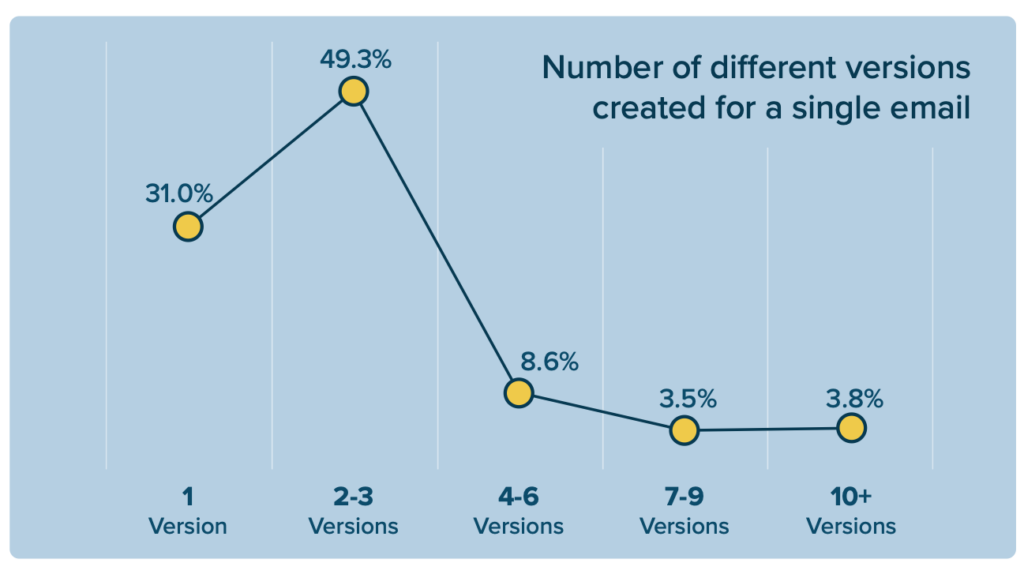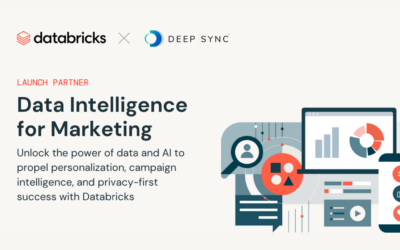There’s no escaping the fact that modern customers love personalization. For email marketers, personalization has a lot of potential—including the opportunity to build stronger relationships with customers through highly targeted messaging.
Not only does this guarantee customer loyalty, but it also helps to pull in new leads. In fact, 89% of business leaders believe personalization will be valuable in achieving success over the next three years.
However, personalization needs data to be effective. In this guide, we’ll explore the biggest benefits of data-powered email personalization and how you can collect the detailed and accurate information you need.
The Role of Data in Email Personalization
To offer personalized experiences, you need to know your audience—beyond the basic knowledge you might gain from market research and focus groups. To truly connect with people, you need to understand them on an individual level and have accurate contact information for them. This is where high-quality data comes in.

Every customer that interacts with your business leaves a digital footprint. However, not all data will provide the detailed insights you need for effective personalization. If you want your personalization efforts to be accurate and effective, you need to collect the right information from the right sources.
Sources and Types of Data to Consider
So, where should you begin? Here are some of the best sources for audience insights:
Sales Data
Each time your business makes a sale, you collect information about a customer’s transaction. This data might be stored on your Customer Relationship Management (CRM) system, sales platform, retail software, or Point of Sale (POS) system—all of which will help you analyze customer buying patterns and sales trends.
Every customer that interacts with your business leaves a digital footprint. However, not all data will provide the detailed insights you need for effective personalization. If you want your personalization efforts to be accurate and effective, you need to collect the right information from the right sources.
Sources and Types of Data to Consider
So, where should you begin? Here are some of the best sources for audience insights:
Sales Data
Each time your business makes a sale, you collect information about a customer’s transaction. This data might be stored on your Customer Relationship Management (CRM) system, sales platform, retail software, or Point of Sale (POS) system—all of which will help you analyze customer buying patterns and sales trends.

Sales data can tell you things like:
- Whether a customer purchased a specific deal or product bundle
- If a customer bought a product alongside another item
- A customer’s preferred payment method
- What products a customer purchased
- Seasonal product trends
This data can support your email personalization in different ways. For example, imagine that a customer often buys certain products together. You could send a targeted email bundling these products with other items they might enjoy. This could boost the average order value and help a customer discover new items from your store.
Customer Feedback and Surveys
Not all forms of customer data require high-tech tools. Customer feedback can be a simple way to understand how your customers think and what they feel. What’s more, feedback is usually easy to find as customers are often happy to share their thoughts about brands—whether it’s specific products or their overall experience—on social media, via email, or through online review sites.
Both positive and negative feedback provide unique insights into how customers view your brand. This can help you personalize emails towards certain customer pain points and concerns.
Online surveys are another form of valuable customer feedback. Using a survey or customer feedback tool, you can set the tone of the discussion and ask questions about the topics that matter to you. For example, what deals or discounts do customers enjoy the most? A mixture of multiple-choice and written answers will help you gain the level of detail you need.
Previous Campaign Data
Once an email campaign is over, you should keep clear records of relevant data, as every click and action can provide valuable insights that can inform future campaigns. Carefully analyze the data and see how it can assist your personalization strategies.
After each campaign, you’ll know more about your audience. What sort of CTAs do they respond to? Which types of emails have the highest open rates? Do subsets of your audience react to your mail in different ways? All this information can be valuable for your personalization efforts.
Website Analytics
Your website can be a veritable goldmine of data, so analyze user journeys across your site to get an accurate reading of how visitors behave. This includes the kinds of content users enjoy, what pain points they encounter, and the product pages they frequent—all of which can help you create more targeted emails.

To gather website data, you’ll need the right website analytics tool. Modern solutions provide a variety of useful features to unpack your data, including:
- Audience reports detailing user demographics, interests, and other data
- Customizable dashboards for easy access to important metrics
- The ability to track users on your site in real-time
Sentiment Analysis
How does your audience feel about your brand? A sentiment analysis seeks to answer this question by using specific tools to analyze customer communications (voice recordings, emails, etc). By assessing people’s tone, they can tell you whether customers are ‘positive’, ‘negative’, or ‘neutral’ about your brand.
Paying attention to sentiment analysis can help you to better understand customer needs. If customers are negative about an aspect of your brand, a more personalized message may help them to feel more favorable.
5 Ways Data Can Upgrade Your Email Personalization
There’s no shortage of data sources to help you personalize emails. But how can you use customer data effectively? Below are some best practices to guide your strategy.
Segmentation and targeting
Unfiltered data is great for providing you with the big picture. If you dig deeper, it can offer much more granular insights into your customers. Segmentation is the process of breaking customer data down into smaller groups. A very basic example would be separating your audience into segments of active vs. inactive customers.
Of course, segmentation can be a much more in-depth process. For instance, you might segment to compare the behavior of mobile vs. desktop users. You could then tailor your personalized content to accommodate both groups better.
You can also break segments into even smaller groups, a process known as micro-segmentation. To continue our earlier example, you might micro-segment mobile users into different age groups.
Ultimately, the more you segment, the more you learn about your customers, allowing you to send extremely targeted messages.
Personalized Content Creation
Customers need to feel a personal connection to engage with your email content. Personalized content creation seeks to deliver the right content to the right groups of customers. This might mean changing the tone, font, or imagery of an email.

Through segmentation, you should have an understanding of the different groups within your audience. Consider the content topics that might appeal to each group. A younger customer, for instance, might respond more to the use of memes and more casual language compared to an older customer.
To understand the best content to create, it can be useful to build audience personas: fictional descriptions of different types of customers within your audience. They should contain the following about a persona:
- Age and gender
- Geographic location
- Employment details such as industry and salary
- Pain points and other psychographic details
While data should always be the most important tool to refine your strategies, audience personas can help you thoughtfully tailor your messaging to different segments.
Behavior-Based Trigger Emails
The success of email marketing is dictated by whether you catch a user at the right time with the right messaging. Behavior-based emails are sent automatically based on specific user actions.
For instance, a customer might trigger an email when a discount becomes available for a product on their wishlist. With online inventory software, you can even combine data sources and go the extra mile to tell customers when popular items are going out of stock, creating a sense of urgency to encourage the sale.
Conversely, behavior-based emails can also be triggered by inaction. In this case, you might trigger an email if a user hasn’t logged into their account after a certain amount of time. The messaging could highlight what the customer has missed, what’s new or coming soon, and offer a discount to win them back.
Location-Based Personalization
As the name suggests, location-based personalization tailors emails to users in specific places, which is particularly useful for businesses that operate across specific regions or countries. Location-based emails can alert customers about sales or deals at nearby stores or based on seasonal promotions.

This form of personalization also makes sure that emails use the correct language for different locations and can tap into localized trends. Through personalized, location-based marketing, customers will feel more connected to your brand, strengthening customer relationships and loyalty.
If your database is lacking location data, a data enhancement solution can help. For example, data enhancement can add geocodes at the rooftop ZIP + 4®, carrier route, or ZIP Code™ level to your database—allowing you to personalize your content by location.
A/B Testing and Optimization
The look and feel of your emails are essential for maintaining user engagement, as even a small shift in image placement or CTA design can have a big impact on user behavior. Identifying the best format for your emails can sometimes be difficult; A/B testing can help you determine the best possible designs.
This approach involves splitting the recipients of your emails, so 50% of respondents receive design A and 50% receive design B. You monitor engagement levels for each design to see which is the most effective.
Through regular A/B testing, you can continuously find new ways to improve your personalizations while gaining an understanding of the types of content that garner the most engagement.
Final thoughts
There’s no escaping personalization for modern businesses. It’s a tactic that’s proven again and again to boost engagement, loyalty, and conversions. But to deliver personalization effectively, you need quality data.
Today, we’ve explored some of the prime sources for data collection, giving you a starting point for your personalization strategies.
Remember, for the best understanding of your customers, always segment your data and build detailed audience personas. Don’t overlook the power of A/B testing to find the best designs for your personalizations and continue to optimize your strategy—from the way you segment data to the design of campaigns.
Data-powered email personalization could take your business to the next level. So, why not give it a go? Craft your personalization strategy today.












0 Comments